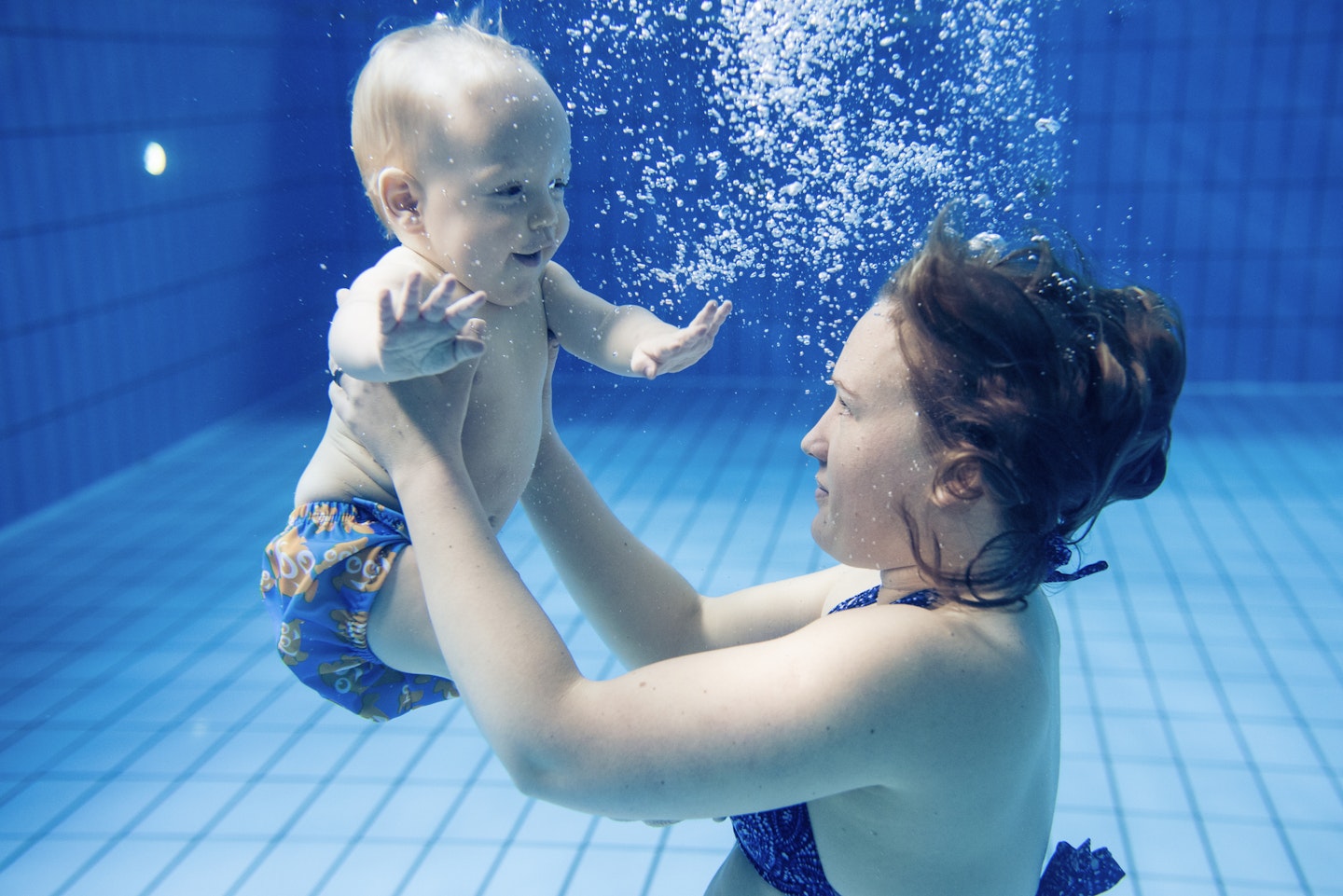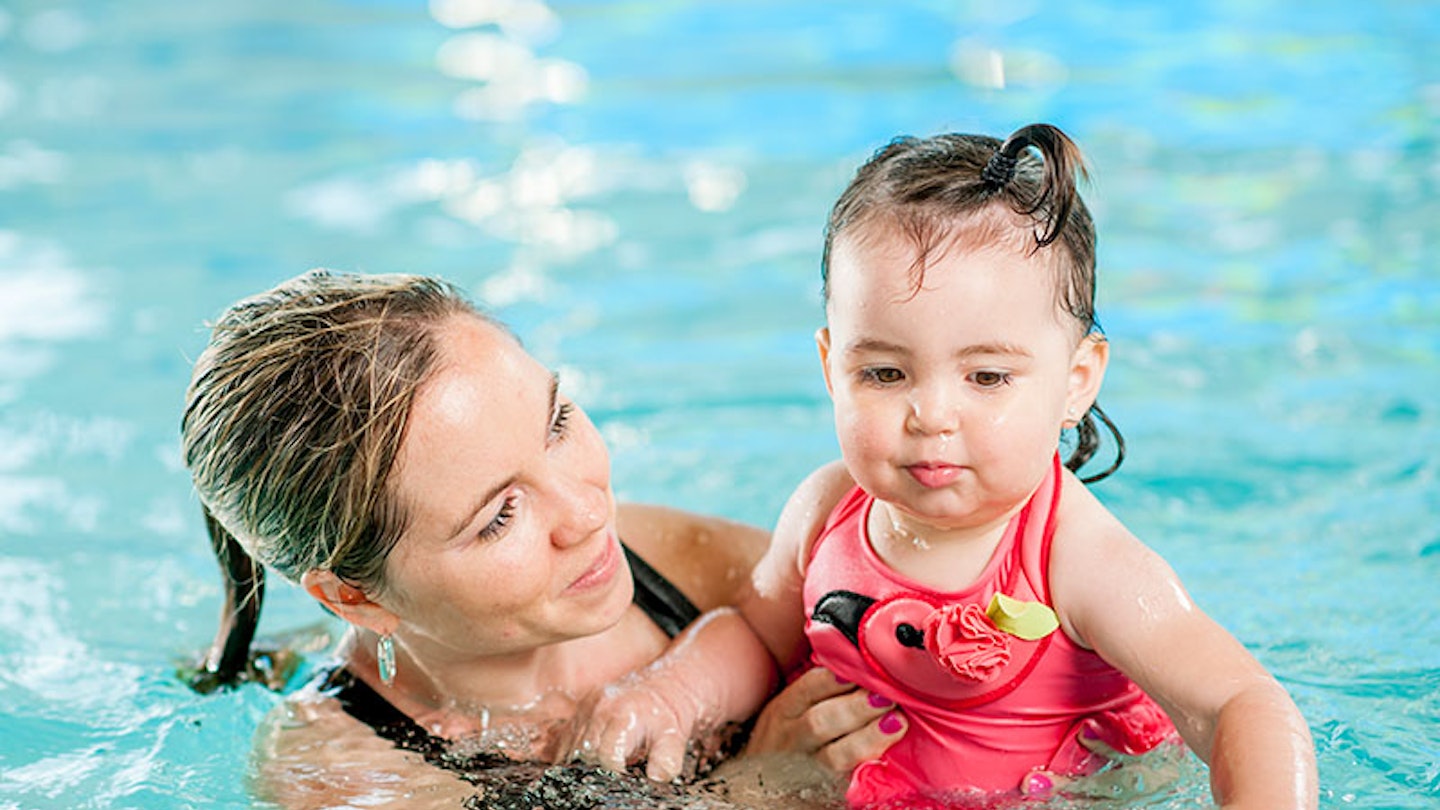Teaching your toddler to swim isn’t just good for strengthening their little muscles and keeping their heart healthy, it’s fun and a great bonding exercise for you and your tot.
According to Ali Beckman, Technical Director and Head of Teaching at Puddle Ducks, the ages of 2 to 3 is the perfect age to get your tot immersed in the water. “The younger they are the better” she says. “At that age the children are getting a lot stronger, they want to explore more, they're inquisitive and everything that they are developing on land, personality-wise, we can use in the pool to help them explore the water environment and learn to swim.”
Keen to get your tot confidently swimming in the water? Read on for Ali’s top tips.
1. Make sure your toddler is confident in the water

This is key, as you’ll never be able to teach your toddler to swim without it. Ali suggests the best way to build your tot’s confidence is to find a pool with either integrated steps or a beach entry, as these give your tot the freedom to explore the water on their own.
“Obviously the parent’s there to support them, but when you have shallow steps, or shallow water, a child can sit and they can move around, they can even crawl on those shallow steps and just explore themselves. They're not being dragged into deep water and put underwater by a parent, they're choosing to do everything themselves.”
A couple of ways Ali suggests you can do this is by throwing your toddler a ball and getting them to push it back to you, or putting a sinking object on shallow steps and letting them look for it. The movement of reaching for the ball is a basic swimming skill and if your tot chooses to place their head underwater to look for the object, this too will increase their confidence in the water.
2. The power of play
Ali stresses if you're taking your child to a pool on your own, you should never try and teach them how to swim. “It's just not going to work, children learn through play,” she says. It’s this that will help increase your tot’s confidence in the water.
“Even in our structured lessons, it's play, but toddlers don't realise they’re learning the things that we're doing when we're playing games in which they are learning to swim. So the worst thing a parent can do is trying to teach the child to swim.”
Ali suggests going to a pool with a metal bar around the side that your toddler can hold on to and to build activities around this, as it will encourage your tot to be independent in the water.
“So much can be gained from a child holding onto the side of the pool, because they start to turn towards you and if they want to reach out to you they then put their feet on the wall and will do a little push towards you. Even the parent putting their hand under the child seat, and sending them to the wall in kind of a seated position, encouraging them to reach, they’re learning that they need to get from their parents to the wall.
"They’re doing everything they need to do to swim to that wall, it's just that we're still supporting them. And if they've got the confidence they may put their head down, which means that the handing of the seat can be raised a little bit and a hand put under their chest to make them flatter in the water, so we're still supporting them there, but they're doing all the fundamental movements to help them get there.”
3. Avoid forced submersions

One of the most important things you shouldn’t do is force your tot under the water.
“Never take a toddler under the water without their absolute permission” says Ali.
“If you force a toddler underwater you can spend months and months building up confidence and then completely destroy that within seconds.
“By forcing them under water they need to know when to take a breath and when to be prepared for it. Many parents feel that swimming is all about being underwater and it's not. It's exciting underwater but we swim on the surface, and everything we do on the surface can be moved into swimming underwater, but it should always be at the baby's choice.”
4. Don’t rely on fixed buoyancy aids
While armbands and arm disks are great, you don’t want your tot to become to reliant on these.
“The problem with fixed buoyancy aids is that children don’t learn about their own buoyancy in the water and what they're capable of doing. If it's a non-fixed buoyancy aid, like a water noodle, all they have to do is push that away when they're ready to swim independently.
“Whereas with a fixed buoyancy aid they have to ask their parents to remove it and by the time you've removed it sometimes the moments are gone and they’ve then decided they’re not ready for it.”
What should toddlers wear swimming?
“Most swimming pools, certainly swimming lessons, will ask for toddlers to be double wrapped,” says Ali. “So they should have an under nappy and an over nappy and the over nappy should have sealed edges. It looks like it's got a cuff around the waist and a cuff around the legs and what that does is that seals, so if they urinate, it will come out but the pool chemicals will deal with this, however, if they poo, the nappy will stop leakage into the pool. Whereas if they're not double-wrapped, anything can happen and we tend to say to keep them double wrapped for at least three months after they are fully potty trained.”
How much are toddler swimming lessons roughly?
Toddler swimming lessons aren’t fixed in price and can vary anywhere from £12 to £20, depending on where you’re based.
“At Puddle Ducks we are charging around £14, which seems to be average,” says Ali. “Sadly the cost of pool hire has now risen massively over the past few years and unfortunately it's put a lot of swim schools out of business and the ones that have survived have had to put their prices up.”
How to find toddler swimming lessons near you
While there isn’t a website with all the toddler swimming lessons listed in the UK, Puddle Ducks do offer nationwide swimming lessons, so you should be able to find a swimming lesson for you tot near you.
Can a toddler go swimming with a cold or ear infection?
While Ali says it’s fine to take your tot swimming with a cold, you should probably avoid it if they have an ear infection.
Sometimes you don't even know that they've got an inner ear infection, because there's no funky stuff but with an outer ear infection you can see it and it’s usually quite gunky and horrible. A lot of the time when babies have got ear infections they're upset and grizzly so you wouldn't want to take them.”
Puddle Ducks teaches children, from birth to 10 years, to swim independently, beautifully and confidently, and to love and respect the water. All swimming is child-led. Their fully-qualified teachers, teach essential life skills and water safety to over 19,000 babies, toddlers, pre-school and primary school children across the UK, every week.
